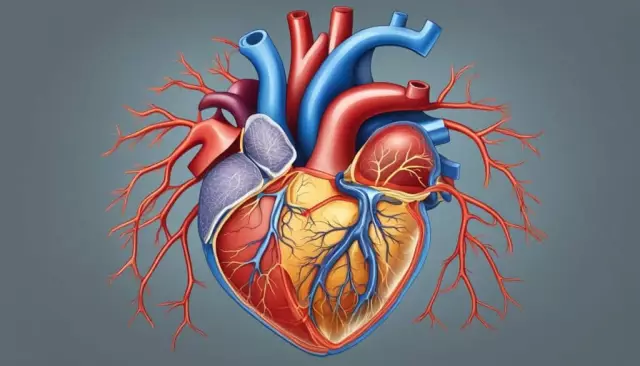- Author Rachel Wainwright [email protected].
- Public 2023-12-15 07:39.
- Last modified 2025-11-02 20:14.
Cardiopathy
The content of the article:
- Causes and risk factors
- Forms of the disease
- Symptoms
- Diagnostics
- Treatment
- Possible complications and consequences
- Forecast
- Prevention
Cardiopathy is the collective name for a group of non-inflammatory heart diseases characterized by structural changes in the heart muscle.

Source: static.independent.co.uk
Pathologies of this kind are recorded in all age groups, but most often they occur in children, adolescents and the elderly.
Causes and risk factors
The mechanism of the development of the disease is not fully understood, in some cases the etiology of cardiopathy cannot be established. The main causes are genetic factors, viral infections, and autoimmune diseases. Approximately 20% of patients develop the disease after suffering infectious myocarditis. Ischemic cardiopathy often develops in patients with a history of myocardial infarction or angina pectoris. Dysplastic cardiopathy is formed against the background of rheumatic diseases.
Risk factors include:
- myocardial anomalies arising in the prenatal period of development;
- endocrine diseases;
- multiple atherosclerotic lesions of the intramural and epicardial branches of the coronary arteries;
- neuromuscular diseases;
- bronchial asthma;
- pneumonia;
- frequent acute respiratory infections;
- arterial hypertension;
- exposure to the body of toxic substances;
- excessive physical activity;
- bad habits;
- poor nutrition.
Forms of the disease
Allocate congenital and acquired, primary and secondary cardiopathy.
Depending on the etiological factor, cardiopathy can be:
- functional - occupies a leading position in the general structure of cardiovascular pathology in children, the prevalence is about 14%;
- ischemic - occurs mainly in men 45-55 years old (about 90% of all cases), it accounts for 5-8% of cases of the total number of clinically expressed forms of ischemic heart disease;
- dyshormonal - occurs due to a lack of sex hormones, is more often observed in women in the climacteric period, as well as in adolescents;
- dysplastic - occurs in the presence of congenital pathologies of the cardiovascular system, progression of heart failure;
- dysmetabolic - develops against the background of thyroid dysfunction, diabetes mellitus;
- infectious toxic (including alcoholic);
- posthypoxic, or metabolic;
- tonsillogenic - develops against the background of chronic tonsillitis (its causative agent, β-hemolytic streptococcus, also affects the heart muscle with prolonged persistence in the body).
Symptoms
Regardless of the form of the disease, the clinical signs of cardiopathy are:
- weakness, fatigue;
- dizziness;
- pallor of the skin, peripheral cyanosis;
- shortness of breath (may be accompanied by attacks of suffocation that occur during excessive physical exertion, stressful situations);
- pain and / or discomfort behind the breastbone;
- cough (with the development of pulmonary edema, liquid sputum is separated, wheezing is heard);
- swelling of the lower extremities;
- muscle weakness;
- enlargement of the liver and spleen (hepatosplenomegaly).
The congenital form of cardiopathy can make its debut already in the first days of a child's life, but more often it manifests itself in primary school age. It is characterized by the appearance of characteristic heart murmurs, especially during physical exertion.
Functional cardiopathy is usually found in early childhood and adolescence. In addition to the main symptoms, there is increased sweating, periodic fainting. Teenagers often complain about the occurrence of extrasystoles (extraordinary contractions of the heart muscle), increased heart rate.

The clinical picture of dyshormonal cardiopathy in males and females has some differences. So, in women, memory loss, neuropsychiatric disorders, sleep disturbances, hot flashes, paresthesias, increased sweating, and frequent urination come to the fore. In men, there are disorders of the genitourinary system, pain in the heart. Signs of damage to the heart muscle are usually not detected.
Diagnostics
Diagnosing cardiopathy in young children can be difficult because they are unable to articulate complaints clearly. Pathology is detected during a regular medical examination or when parents detect alarming symptoms (shortness of breath, cyanosis, etc.).
To make a diagnosis, they collect complaints and anamnesis, physical, instrumental and laboratory examinations.
From the methods of instrumental diagnostics for suspected cardiopathy, they are used:
- electrocardiography - makes it possible to detect cardiac arrhythmias, track changes in the ventricles and / or atria;
- echocardiography - allows you to assess the degree of violation of the systolic and diastolic function of the ventricles;
- X-ray examination of the lungs - allows you to determine the presence of fluid in the lungs or a change in their size;
- to ontrast ventriculography of the heart - allows you to detect expansion of the ventricles of the heart or their other changes;
- magnetic resonance imaging, multispiral computed tomography - allow you to detect structural changes in the heart;
- 99mTc-pyrophosphate myocardial scintigraphy - usually used when echocardiography is impossible (poor ultrasound window), the method allows quantitative assessment of the systolic and diastolic functions of the left ventricle.
In difficult cases, endomyocardial biopsy is used, which makes it possible to assess the degree of destruction of muscle filaments in a biopsy. The study is shown, first of all, in the presence of cardiac muscle dysfunction and concomitant systemic disease that affects the myocardium and is amenable to specific treatment (sarcoidosis, etc.).
Laboratory examination includes a general analysis of blood and urine, a biochemical blood test (determination of the concentration of total cholesterol, low density lipoproteins, triglycerides).
Differential diagnosis of cardiopathy is carried out with lesions of the heart valves, left ventricular aneurysm, ischemic heart disease, hypertensive disease, chronic recurrent myocarditis.
Treatment
The choice of treatment regimen for cardiopathy depends on the form of the disease. With secondary cardiopathy, therapy, in addition to correcting cardiac disorders, consists in treating the underlying disease that provoked the pathological process.
Drug therapy for cardiopathy consists in the use of beta-blockers, angiotensin-converting enzyme inhibitors, antihypoxants, antiplatelet agents, vitamin complexes (B vitamins), if necessary, mild sedatives, for example, valerian preparations.
In the case of the development of dysmetabolic cardiopathy, drugs are used that normalize metabolic processes in the heart muscle, as well as a diet that normalizes metabolism.

Source: ritmserdca.ru
With dyshormonal cardiopathy, hormonal drugs may be required. With stagnation of blood in the systemic circulation and / or in the lungs, diuretics are prescribed. In the case of severe edema, diuretics are combined with aldosterone antagonists. If the patient has left ventricular heart failure, the main treatment is supplemented by the use of nitrates. Patients with atrial fibrillation are shown cardiac glycosides. In the absence of a positive effect from monotherapy with these drugs, they are combined with angiotensin-converting enzyme inhibitors, diuretics (under the control of electrocardiography and the concentration of electrolytes in the patient's blood).
In the treatment of functional cardiopathy, physiotherapy is effective: laser therapy, hydrogen sulfide baths, electrophoresis of bromine or calcium. Interference therapy may be prescribed for children over 10 years of age. Spa treatment is recommended.
Patients with cardiopathy are shown regular exercise therapy. In some cases, work with a psychologist or psychotherapist is required. In chronic heart failure, a diet that limits the use of table salt is recommended (especially in the case of edema).
Possible complications and consequences
Cardiopathy can be complicated by the development of arrhythmia, angina pectoris, ischemic heart disease, arterial hypertension, thrombosis, pulmonary edema, chronic heart failure, endocarditis.
Forecast
With early detection of cardiopathy, properly selected treatment and following the doctor's prescriptions, the prognosis is favorable. With late detection of pathology, as well as in the case of complications, the prognosis worsens, the risk of patient disability is high, and a lethal outcome is possible.
Prevention
Prevention of the development of cardiopathy includes, in addition to timely treatment of diseases that can lead to its development, the following measures;
- rejection of bad habits;
- balanced diet;
- adequate physical activity;
- rational work and rest regime;
- avoiding stressful situations, increasing stress resistance.
YouTube video related to the article:

Anna Aksenova Medical journalist About the author
Education: 2004-2007 "First Kiev Medical College" specialty "Laboratory Diagnostics".
The information is generalized and provided for informational purposes only. At the first sign of illness, see your doctor. Self-medication is hazardous to health!






